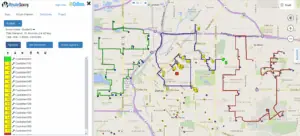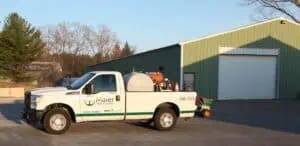When it comes to planning routes for deliveries, pickups, service calls, or sales calls, many route planners mistakenly think the best option is always the shortest route. This is not the case. There are scenarios in which you should optimize the route based on the least miles driven. There also are scenarios when you should optimize the route based on the fastest arrival time. The good news is that RouteSavvy route planning software offers both options.
What’s The Difference Between the Shortest Vs Fastest Route?
The shortest route is the route that drives shortest distance, i.e., the least number of miles driven to accomplish the deliveries, pickups, service calls, or sales calls for the day. This also is called “distance-based” routing.
- Special Note re Shortest Route: The shortest route is not always the fastest route. If the shortest route involves driving a highway or major road during rush-hour traffic, it’s possible your fleet vehicle could be sitting at a dead stop because of traffic volume.
The fastest route is the route that takes the least amount of time to accomplish all the stops for the day. When you use route planning software to calculate the fastest route, the software may create a route that involves driving surface streets, back roads, and frontage roads, and/or avoiding known areas of traffic congestion at certain times of day.
- Special Note re Fastest Route: This assumes that the driver is driving the speed limit, and not driving 100 miles per hour or weaving through traffic in a way that compromises public safety.
Shortest Vs. Fastest Route: Which Should You Choose?
There are many factors that would influence whether you should optimize your routes based on the least miles driven or the least amount of time to accomplish the day’s deliveries, pick-ups, service calls, or sales calls. Here are some highlights and general guidelines about how to make a strategic decision about which way to optimize your routes.
Shortest Route Decision Points
You would optimize your routes for the shortest route (least miles driven) in the following circumstances:
- Your fleet is comprised of gas guzzlers: If you’re driving a vehicle that guzzles gas, then driving less miles may be more important than a fast arrival time. For example, if you’re in the specialty waste business and you haven’t shifted to electric or natural gas-powered vehicles, the typical diesel garbage truck only gets 3 miles per gallon. Or, if you’re driving a 26-foot-long box truck, you’re only getting between 8-13 miles per gallon. Bottom line, if your fleet vehicles are gas guzzlers, then optimizing for the least miles driven (the shortest route in terms of distance) saves money on fuel costs – which just happens to be 60% of your fleet’s operating expenses.
- You’re compensating drivers by paying mileage: Many non-profits use volunteer drivers and compensate them based on mileage. In those instances, a route optimized for the least miles driven will reduce mileage reimbursement expenses.
- You want to reduce emissions & reduce your carbon footprint: For those company owners & managers who want their company to reduce their carbon emissions to help fight global warming & climate change, optimizing by the shortest route (least miles driven) reduces your carbon footprint.
Fastest Route Decision Points
You would optimize your routes for the fastest route in the following circumstances:
- You’re transporting perishable goods: If you’re delivering perishable goods (flowers, hot food, prepared meals, medicines that have a short shelf life or need refrigeration, donated organs, etc.), then the fastest route makes the most sense.
- You provide emergency service work: If you’re in a business where you deal with emergencies (plumbers, HVAC professionals, etc.), then routing for the fastest arrival time makes the most sense.
- You have a set arrival deadline: If you’re in a business where you’ve promised a specific arrival time, then optimizing a route based on the fastest arrival time may be what’s needed.
RouteSavvy Optimizes Routes Both Ways

Whether your business circumstances require the least miles driven, or the least amount of time spent to get the day’s deliveries, pick-ups, service calls, or sales calls completed, RouteSavvy has you covered.
Want to take RouteSavvy for a test drive & learn about its route optimization capabilities? Contact us for a DEMO today.




